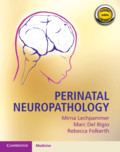Book contents
- Perinatal Neuropathology
- Perinatal Neuropathology
- Copyright page
- Contents
- Preface
- Acknowledgments
- Abbreviations
- Section I Techniques and Practical Considerations
- Section 2 Human Nervous System Development
- Section 3 Stillbirth
- Autolysis, Artifacts, and Stillbirths
- Stillbirths
- Chapter 28 Neuropathology of Stillbirth
- Section 4 Disruptions / Hypoxic-Ischemic Injury
- Section 5 Malformations
- Section 6 Perinatal Neurooncology
- Section 7 Spinal and Neuromuscular Disorders
- Section 8 Eye Disorders
- Section 9 Infections: In Utero Infections
- Section 10 Metabolic / Toxic Disorders: Storage Diseases
- Section 11 Forensic Neuropathology
- Appendix 1 Technical Considerations in Perinatal CNS
- Index
- References
Chapter 28 - Neuropathology of Stillbirth
from Stillbirths
Published online by Cambridge University Press: 07 August 2021
- Perinatal Neuropathology
- Perinatal Neuropathology
- Copyright page
- Contents
- Preface
- Acknowledgments
- Abbreviations
- Section I Techniques and Practical Considerations
- Section 2 Human Nervous System Development
- Section 3 Stillbirth
- Autolysis, Artifacts, and Stillbirths
- Stillbirths
- Chapter 28 Neuropathology of Stillbirth
- Section 4 Disruptions / Hypoxic-Ischemic Injury
- Section 5 Malformations
- Section 6 Perinatal Neurooncology
- Section 7 Spinal and Neuromuscular Disorders
- Section 8 Eye Disorders
- Section 9 Infections: In Utero Infections
- Section 10 Metabolic / Toxic Disorders: Storage Diseases
- Section 11 Forensic Neuropathology
- Appendix 1 Technical Considerations in Perinatal CNS
- Index
- References
Summary
Miscarriage is defined as the loss of an embryo or fetus before the 20th week of pregnancy (1). Stillbirth in general refers to a natural loss of the products of conception after the 20th week of gestation. However, the administrative and legal definitions of stillbirth vary. For example, the US Centers for Disease Control uses the definition “fetal deaths whose birth weight is of 350 g or more, or if weight is unknown, of 20 completed weeks gestation or more, calculated from the date last normal menstrual period,” whereas other jurisdictions use 24 weeks (typical limit of viability) or 28 weeks as cutoffs (2–4). Notwithstanding the varied definitions, the rate of stillbirth is approximately 4 per 1000 total births in high-income countries, and up to 35 per 1000 births in sub-Saharan Africa and South Asia, with a general decline in frequency during the past three decades (5, 6).
- Type
- Chapter
- Information
- Perinatal Neuropathology , pp. 139 - 144Publisher: Cambridge University PressPrint publication year: 2021

